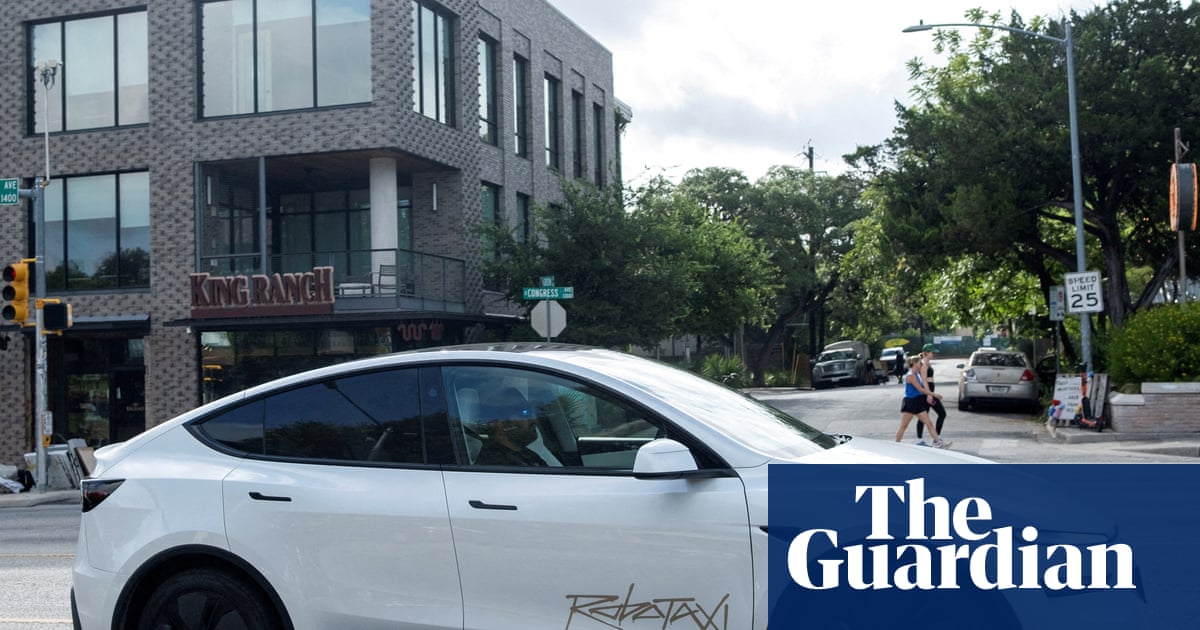The company’s rollout of its new driverless cars has gotten off to a wobbly start – and rival Waymo remains well ahead
After years of promising investors that millions of Tesla robotaxis would soon fill the streets, Elon Musk debuted his driverless car service in a limited public rollout in Austin, Texas. It did not go smoothly.
The 22 June launch initially appeared successful enough, with a flood of videos from pro-Tesla social media influencers praising the service and sharing footage of their rides. Musk celebrated it as a triumph, and the following day, Tesla’s stock rose nearly 10%.
What quickly became apparent, however, was that the same influencer videos Musk promoted also depicted the self-driving cars appearing to break traffic laws or struggle to properly function. By Tuesday, the National Highway Traffic Safety Administration (NHTSA) had opened an investigation into the service and requested information from Tesla on the incidents.



What’s funny here is that Tesla used all of the Tesla owners driving habits to train.
One thing this means is that when it’s “socially acceptable” to go +20mph it’s going to. Not that that makes it right, but what it also means is that they didn’t sanitize their data.
So think of the worst Tesla driver you know. They helped train FSD.
Relevant:
Every time I see this I chuckle regardless of how many times.
There is a segment of highway near Budapest where cops often hang out on an overpass with a speed camera. Teslas do a light phantom brake under that overpass, like going from speed limit to 80% speed limit, because apparently the car learned that that’s what it should do there.
I wouldn’t have believed it’s that stupid, but there is a whole discussion on local owner groups about that specific spot, and I’ve also seen it first hand from the passenger seat.
Just to clarify…
How bad is Budapest traffic? Is it LA? Or New Jersey?
Most drivers are good at driving, terrible at being good people. So it’s not like you get cut off a lot, and there is less texting and driving than in other places, but there are more people road raging. I’ve seen someone getting brake checked by police, and I’ve also seen someone brake checking police.
Traffic jams happen, but it’s not LA level. The roads are terrible though. The motorway that this thing is on is notoriously unsafe because it has much tighter turns that it should have, and it’s rated 110 kmh rather than 130 as a result, and that is still too fast.
[x] doubt. :P
but that’s just because I assume everyone is a terrible driver. Around here, we have people struggling with the whole zipper merge thing, though.
Ok, let me expand on that. Drivers in Hungary tend to be more attentive and in control of their vehicles, but also more aggressive than in Western Europe is what I mean.
In much of Europe you don’t need a car to live, so the training requirements to get a driving licence are higher.
I mean the data IS sanitized, but not to the level that would have required certain human things to not happen.
Part of what’s led to its improvement over the years is better going through the data and removing bad things or properly labeling them.
That left turn that was cut to short makes it into the first set of training as a cursory look at it seemed okay, and then they see that cars are cutting turns to short. So they go through the data again and try to find examples of it and then label them properly so it doesn’t think it’s okay.
But that’s not a simple process, and then trying to only have certain good behaviors gets really hard because they’re actually very uncommon in normal driving because the bad behavior is socially acceptable.
You can establish rules in top of the neural net output. No acceleration higher than 0.3g. No speed higher than the limit + 5 (if you know what the limit is, which teslas struggle with to this day). No running of red lights.
You can, yes.
They didn’t seem to, but they can.
The thing is that you have to break the law to be an effective and even safe driver. Going way under the limit or refusing to go into the opposite lane for a moment means that you cause traffic congestion and piss people off. Waymos definitely break laws at times, I’ve seen it personally. And other times waymos get too “safe” and end up locked in place for 30 min at a time. The real world is a chaotic place and there’s always been a discrepancy between what the laws are and how people actually drive. Lidar helps see things humans cant, but the main problem is the intelligence required, which may improve over time
The biggest problem is if you’re training in the extremes.
And they did.
The stopping for 30 minutes has more to do with “I don’t know”, which is something Tesla could do more of, imo. (And certainly not in the way they just set you up for a crash and hand it over after it’s too late.)
The worst Telsa driver I know. Hum. That’s a tough competition.